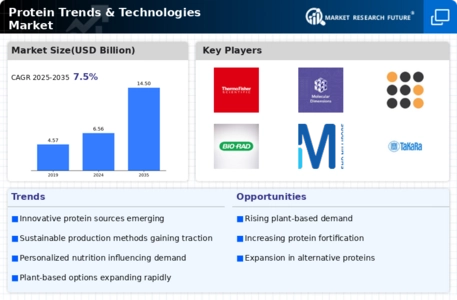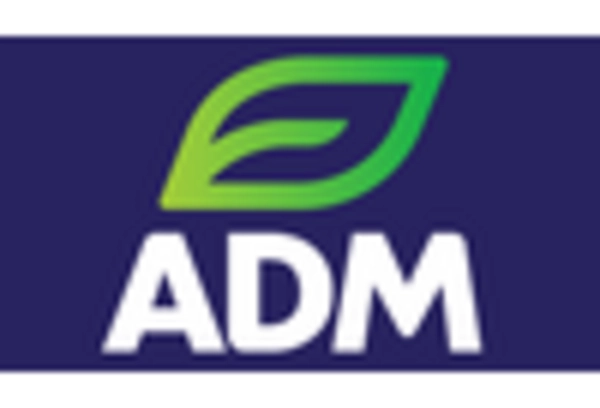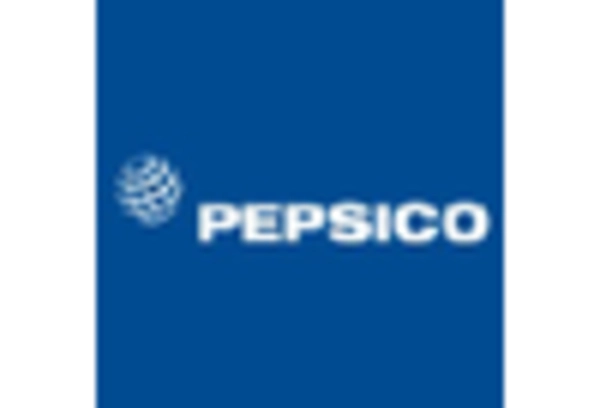Protein chip
Tandem Mass spectrometry
Electrophoresis
Chromatography
Liquid Chromatography
High-Performance liquid chromatography
Nuclear magnetic resonance
X-ray crystallography
Others
Protein identification
De novo (peptide) sequencing
Protein quantitation
Protein structure determination
Biomarker
Proteogenomics
Diagnostics
Antibody characterization
Treatment development
Pharmaceutical companies
Biotechnology companies
Research institutes
Others
Protein Trends & Technologies by TechnologyProtein chip
Tandem Mass spectrometry
Electrophoresis
Chromatography
Liquid Chromatography
High-Performance liquid chromatography
Nuclear magnetic resonance
X-ray crystallography
Others
Protein identification
De novo (peptide) sequencing
Protein quantitation
Protein structure determination
Biomarker
Proteogenomics
Diagnostics
Antibody characterization
Treatment development
Pharmaceutical companies
Biotechnology companies
Research institutes
Others
Protein Trends & Technologies by TechnologyProtein chip
Tandem Mass spectrometry
Electrophoresis
Chromatography
Liquid Chromatography
High-Performance liquid chromatography
Nuclear magnetic resonance
X-ray crystallography
Others
Protein identification
De novo (peptide) sequencing
Protein quantitation
Protein structure determination
Biomarker
Proteogenomics
Diagnostics
Antibody characterization
Treatment development
Pharmaceutical companies
Biotechnology companies
Research institutes
Others
Protein Trends & Technologies by TechnologyProtein chip
Tandem Mass spectrometry
Electrophoresis
Chromatography
Liquid Chromatography
High-Performance liquid chromatography
Nuclear magnetic resonance
X-ray crystallography
Others
Protein identification
De novo (peptide) sequencing
Protein quantitation
Protein structure determination
Biomarker
Proteogenomics
Diagnostics
Antibody characterization
Treatment development
Pharmaceutical companies
Biotechnology companies
Research institutes
Others
Protein Trends & Technologies by TechnologyProtein chip
Tandem Mass spectrometry
Electrophoresis
Chromatography
Liquid Chromatography
High-Performance liquid chromatography
Nuclear magnetic resonance
X-ray crystallography
Others
Protein identification
De novo (peptide) sequencing
Protein quantitation
Protein structure determination
Biomarker
Proteogenomics
Diagnostics
Antibody characterization
Treatment development
Pharmaceutical companies
Biotechnology companies
Research institutes
Others
Germany Outlook (USD Billion, 2018-2032)
Protein Trends & Technologies by TechnologyProtein chip
Tandem Mass spectrometry
Electrophoresis
Chromatography
Liquid Chromatography
High-Performance liquid chromatography
Nuclear magnetic resonance
X-ray crystallography
Others
Protein identification
De novo (peptide) sequencing
Protein quantitation
Protein structure determination
Biomarker
Proteogenomics
Diagnostics
Antibody characterization
Treatment development
Pharmaceutical companies
Biotechnology companies
Research institutes
Others
Protein Trends & Technologies by TechnologyProtein chip
Tandem Mass spectrometry
Electrophoresis
Chromatography
Liquid Chromatography
High-Performance liquid chromatography
Nuclear magnetic resonance
X-ray crystallography
Others
Protein identification
De novo (peptide) sequencing
Protein quantitation
Protein structure determination
Biomarker
Proteogenomics
Diagnostics
Antibody characterization
Treatment development
Pharmaceutical companies
Biotechnology companies
Research institutes
Others
Protein Trends & Technologies by TechnologyProtein chip
Tandem Mass spectrometry
Electrophoresis
Chromatography
Liquid Chromatography
High-Performance liquid chromatography
Nuclear magnetic resonance
X-ray crystallography
Others
Protein identification
De novo (peptide) sequencing
Protein quantitation
Protein structure determination
Biomarker
Proteogenomics
Diagnostics
Antibody characterization
Treatment development
Pharmaceutical companies
Biotechnology companies
Research institutes
Others
Protein Trends & Technologies by TechnologyProtein chip
Tandem Mass spectrometry
Electrophoresis
Chromatography
Liquid Chromatography
High-Performance liquid chromatography
Nuclear magnetic resonance
X-ray crystallography
Others
Protein identification
De novo (peptide) sequencing
Protein quantitation
Protein structure determination
Biomarker
Proteogenomics
Diagnostics
Antibody characterization
Treatment development
Pharmaceutical companies
Biotechnology companies
Research institutes
Others
Protein Trends & Technologies by TechnologyProtein chip
Tandem Mass spectrometry
Electrophoresis
Chromatography
Liquid Chromatography
High-Performance liquid chromatography
Nuclear magnetic resonance
X-ray crystallography
Others
Protein identification
De novo (peptide) sequencing
Protein quantitation
Protein structure determination
Biomarker
Proteogenomics
Diagnostics
Antibody characterization
Treatment development
Pharmaceutical companies
Biotechnology companies
Research institutes
Others
Protein Trends & Technologies by TechnologyProtein chip
Tandem Mass spectrometry
Electrophoresis
Chromatography
Liquid Chromatography
High-Performance liquid chromatography
Nuclear magnetic resonance
X-ray crystallography
Others
Protein identification
De novo (peptide) sequencing
Protein quantitation
Protein structure determination
Biomarker
Proteogenomics
Diagnostics
Antibody characterization
Treatment development
Pharmaceutical companies
Biotechnology companies
Research institutes
Others
Protein Trends & Technologies by TechnologyProtein chip
Tandem Mass spectrometry
Electrophoresis
Chromatography
Liquid Chromatography
High-Performance liquid chromatography
Nuclear magnetic resonance
X-ray crystallography
Others
Protein identification
De novo (peptide) sequencing
Protein quantitation
Protein structure determination
Biomarker
Proteogenomics
Diagnostics
Antibody characterization
Treatment development
Pharmaceutical companies
Biotechnology companies
Research institutes
Others
Protein Trends & Technologies by TechnologyProtein chip
Tandem Mass spectrometry
Electrophoresis
Chromatography
Liquid Chromatography
High-Performance liquid chromatography
Nuclear magnetic resonance
X-ray crystallography
Others
Protein identification
De novo (peptide) sequencing
Protein quantitation
Protein structure determination
Biomarker
Proteogenomics
Diagnostics
Antibody characterization
Treatment development
Pharmaceutical companies
Biotechnology companies
Research institutes
Others
Protein Trends & Technologies by TechnologyProtein chip
Tandem Mass spectrometry
Electrophoresis
Chromatography
Liquid Chromatography
High-Performance liquid chromatography
Nuclear magnetic resonance
X-ray crystallography
Others
Protein identification
De novo (peptide) sequencing
Protein quantitation
Protein structure determination
Biomarker
Proteogenomics
Diagnostics
Antibody characterization
Treatment development
Pharmaceutical companies
Biotechnology companies
Research institutes
Others
Protein Trends & Technologies by TechnologyProtein chip
Tandem Mass spectrometry
Electrophoresis
Chromatography
Liquid Chromatography
High-Performance liquid chromatography
Nuclear magnetic resonance
X-ray crystallography
Others
Protein identification
De novo (peptide) sequencing
Protein quantitation
Protein structure determination
Biomarker
Proteogenomics
Diagnostics
Antibody characterization
Treatment development
Pharmaceutical companies
Biotechnology companies
Research institutes
Others
Protein Trends & Technologies by TechnologyProtein chip
Tandem Mass spectrometry
Electrophoresis
Chromatography
Liquid Chromatography
High-Performance liquid chromatography
Nuclear magnetic resonance
X-ray crystallography
Others
Protein identification
De novo (peptide) sequencing
Protein quantitation
Protein structure determination
Biomarker
Proteogenomics
Diagnostics
Antibody characterization
Treatment development
Pharmaceutical companies
Biotechnology companies
Research institutes
Others
Protein Trends & Technologies by TechnologyProtein chip
Tandem Mass spectrometry
Electrophoresis
Chromatography
Liquid Chromatography
High-Performance liquid chromatography
Nuclear magnetic resonance
X-ray crystallography
Others
Protein identification
De novo (peptide) sequencing
Protein quantitation
Protein structure determination
Biomarker
Proteogenomics
Diagnostics
Antibody characterization
Treatment development
Pharmaceutical companies
Biotechnology companies
Research institutes
Others
Protein Trends & Technologies by TechnologyProtein chip
Tandem Mass spectrometry
Electrophoresis
Chromatography
Liquid Chromatography
High-Performance liquid chromatography
Nuclear magnetic resonance
X-ray crystallography
Others
Protein identification
De novo (peptide) sequencing
Protein quantitation
Protein structure determination
Biomarker
Proteogenomics
Diagnostics
Antibody characterization
Treatment development
Pharmaceutical companies
Biotechnology companies
Research institutes
Others
Protein Trends & Technologies by TechnologyProtein chip
Tandem Mass spectrometry
Electrophoresis
Chromatography
Liquid Chromatography
High-Performance liquid chromatography
Nuclear magnetic resonance
X-ray crystallography
Others
Protein identification
De novo (peptide) sequencing
Protein quantitation
Protein structure determination
Biomarker
Proteogenomics
Diagnostics
Antibody characterization
Treatment development
Pharmaceutical companies
Biotechnology companies
Research institutes
Others
Protein Trends & Technologies by TechnologyProtein chip
Tandem Mass spectrometry
Electrophoresis
Chromatography
Liquid Chromatography
High-Performance liquid chromatography
Nuclear magnetic resonance
X-ray crystallography
Others
Protein identification
De novo (peptide) sequencing
Protein quantitation
Protein structure determination
Biomarker
Proteogenomics
Diagnostics
Antibody characterization
Treatment development
Pharmaceutical companies
Biotechnology companies
Research institutes
Others
Protein Trends & Technologies by TechnologyProtein chip
Tandem Mass spectrometry
Electrophoresis
Chromatography
Liquid Chromatography
High-Performance liquid chromatography
Nuclear magnetic resonance
X-ray crystallography
Others
Protein identification
De novo (peptide) sequencing
Protein quantitation
Protein structure determination
Biomarker
Proteogenomics
Diagnostics
Antibody characterization
Treatment development
Pharmaceutical companies
Biotechnology companies
Research institutes
Others

















Leave a Comment